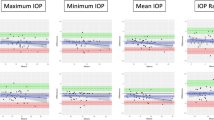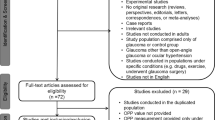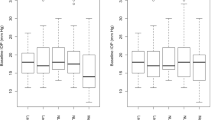Abstract
This systematic review and meta-analysis examines the relationship between intraocular pressure (IOP) parameters derived from the water drinking test (WDT) and diurnal IOP monitoring, and evaluates the reproducibility of the WDT and its association with future glaucomatous visual field (VF) loss. A literature search was performed on PubMed, EMBASE, and Cochrane Library from inception to 31 March 2023. Cohort, cross-sectional and observational studies reporting WDT results in glaucoma patients were included. Meta analysis with random-effect model was performed using “metafor” package in R version 3.2.1. 641 studies were identified on initial literature search. 38 studies (2479 subjects) were included in final analysis. Meta-analytic estimates of 5 studies (310 subjects) found strong positive correlation in peak IOP between the WDT and diurnal IOP monitoring (r = 0.92, 95% CI = 0.75, 1.08, p < 0.0001). However, there was only weak positive correlation for IOP fluctuation between both methods (r = 0.26, 95% CI = 0.06,0.47, p < 0.0001). Meta-analytic estimates of 3 studies (189 subjects) suggested a trend of the diurnal peak IOP being lower than that derived from the WDT (MD = −2.37 mmHg, 95% Limit of Agreement (LOA) =−5.58,0.84, p = 0.147). Two studies found that a higher WDT peak IOP was associated with greater future VF progression. Two studies demonstrated good reproducibility in peak IOP measurements for WDTs conducted across different days. In conclusion, there was a strong positive correlation between IOP peak measurements from the WDT and diurnal IOP monitoring in glaucoma patients. The WDT peak IOP demonstrated good reproducibility and may be associated with greater future VF progression.
摘要
本系统综述和荟萃分析了饮水实验 (WDT) 和昼夜眼内压 (IOP) 参数之间的关系, 并且评估了饮水实验的可重复性及其与未来青光眼视野 (VF) 缺损的联系。我们对截止至2023年3月31日, 在PubMed、EMBASE和Cochrane等数据库进行了文献检索。研究纳入了报告青光眼患者WDT结果的队列、横断面和观察性研究。使用R版本3.2.1中的“meta for”软件包进行随机效应模型的荟萃分析。初步文献检索共641项研究。研究最终纳入了38项研究 (2479例受试者) 。5项研究 (310例受试者) 的荟萃分析发现, WDT和昼夜IOP监测之间的峰值IOP存在很强的正相关性 (r = 0.92, 95%CI = 0.75, 1.08, p < 0.0001) 。然而, 两种方法测量的眼压波动仅呈微弱的正相关 (r = 0.26, 95% CI = 0.06, 0.47, p < 0.0001) 。3项研究 (189例受试者) 的Meta分析表明, 昼夜峰值IOP有低于WDT得出的值的趋势 (MD = −2.37 mmHg, 95%一致性限值 (LOA) =−5.58, 0.84, p = 0.147) 。两项研究发现, 更高的WDT峰值IOP与更严重的未来视野缺损进展有关。两项研究证明, 在不同日期进行的WDT的峰值IOP 测量具有良好的可重复性。总之, 在青光眼患者中, WDT的IOP峰值测量值与昼夜IOP监测值之间存在强正相关性。WDT峰值IOP表现出良好的重现性, 可能与未来更大的VF进展相关。
This is a preview of subscription content, access via your institution
Access options
Subscribe to this journal
Receive 18 print issues and online access
$259.00 per year
only $14.39 per issue
Buy this article
- Purchase on Springer Link
- Instant access to full article PDF
Prices may be subject to local taxes which are calculated during checkout




Similar content being viewed by others
Data availability
The datasets generated during and/or analysed during the current study are available from the corresponding author on reasonable request.
References
Thomas S, Hodge W, Malvankar-Mehta M. The cost-effectiveness analysis of teleglaucoma screening device Bhattacharya S (ed). PLOS ONE. 2015;10:e0137913.
Tham Y-C, Li X, Wong TY, Quigley HA, Aung T, Cheng C-Y. Global prevalence of glaucoma and projections of glaucoma burden through 2040. Ophthalmology. 2014;121:2081–90.
Sultan MB, Mansberger SL, Lee PP. Understanding the importance of IOP variables in glaucoma: a systematic review. Surv Ophthalmol. 2009;54:643–62.
Yang Y, Zhang X, Chen Z, Wei Y, Ye Q, Fan Y, et al. Intraocular pressure and diurnal fluctuation of open-angle glaucoma and ocular hypertension: a baseline report from the LiGHT China trial cohort. Br J Ophthalmol. 2023;107:823–7.
Jonas JB, Budde WM, Stroux A, Oberacher-Velten IM, Jünemann A. Diurnal intraocular pressure profiles and progression of chronic open-angle glaucoma. Eye. 2007;21:948–51.
Susanna R, Clement C, Goldberg I, Hatanaka M. Applications of the water drinking test in glaucoma management: water drinking test and glaucoma. Clin Exp Ophthalmol. 2017;45:625–31.
Nørskov K. the water provocative test. Acta Ophthalmol (Copenh). 2009;45:57–67.
Khoo PY, Cheng TC, Md Din N. Water drinking test in glaucoma management: a review of the literature. Malays J Ophthalmol. 2022;4:252–61.
Page MJ, McKenzie JE, Bossuyt PM, Boutron I, Hoffmann TC, Mulrow CD, et al. The PRISMA 2020 statement: an updated guideline for reporting systematic reviews. BMJ. 2021;372:n71.
Wells G, Shea B, O’Connell D, Peterson J, Welch V, Losos M, et al. The Newcastle-Ottawascale(NOS) for assessing the quality of non randomised studies in meta-analysis. Available at: http://www.ohri.ca/programs/clinical_epidemiology/oxford.asp.
Rupinski MT, Dunlap WP. Approximating pearson product-moment correlations from Kendall’s Tau and Spearman’s Rho. Educ Psychol Meas. 1996;56:419–29.
Welz T, Doebler P, Pauly M. Fisher transformation based confidence intervals of correlations in fixed‐ and random‐effects meta‐analysis. Br J Math Stat Psychol. 2022;75:1–22.
Mukaka MM. Statistics corner: A guide to appropriate use of correlation coefficient in medical research. Malawi Med J J Med Assoc Malawi. 2012;24:69–71.
Joosten A, Desebbe O, Suehiro K, Murphy LS-L, Essiet M, Alexander B, et al. Accuracy and precision of non-invasive cardiac output monitoring devices in perioperative medicine: a systematic review and meta-analysis. Br J Anaesth. 2017;118:298–310.
Beheshti A, Chavanon M-L, Christiansen H. Emotion dysregulation in adults with attention deficit hyperactivity disorder: a meta-analysis. BMC Psychiatry. 2020;20:120.
Nicolela Susanna C, Nicolela Susanna B, Nicolela Susanna F, Susanna Jr R Peak Intraocular Pressure Time during Water Drinking Test and Its Relationship with Glaucoma Severity. J. Ophthalmic Vis. Res. Available at: https://knepublishing.com/index.php/JOVR/article/view/10167 [Accessed June 17, 2023] (2022).
Kadambi S, Balekudaru S, Lingam V, George R. Comparison of intraocular pressure variability detected by day diurnal variation to that evoked by water drinking. Indian J Ophthalmol. 2021;69:1414.
Ozyol P, Özyol E, Baldemir E. Intraocular pressure dynamics with prostaglandin analogs: a clinical application of water-drinking test. Clin Ophthalmol. 2016; 10:1351–6.
Razeghinejad MR, Tajbakhsh Z, Nowroozzadeh MH, Havens SJ, Ghate D, Gulati V. The water-drinking test revisited: an analysis of test results in subjects with glaucoma. Semin Ophthalmol 2018;33:517–24.
Almeida, Scoralick ALB I, Dias DT, Ushida M, Dorairaj S, Gracitelli CP, et al. Comparison between provocative test-based and long-term intraocular pressure parameters in patients with stable open-angle glaucoma. Eur J Ophthalmol. 2021;31:453–9.
Özyol E, Özyol P, Karalezli A. Reproducibility of the water-drinking test in patients with exfoliation syndrome and exfoliative glaucoma. Acta Ophthalmol (Copenh). 2016;94:e795–e798.
Vasconcelos-Moraes CG, Susanna R. Correlation between the water drinking test and modified diurnal tension curve in untreated glaucomatous eyes. Clinics. 2008;63:433–6.
Susanna R, Hatanaka M, Vessani RM, Pinheiro A, Morita C. Correlation of asymmetric glaucomatous visual field damage and water-drinking test response. Investig Opthalmology Vis Sci. 2006;47:641.
Vetrugno M, Sisto D, Trabucco T, Balducci F, Noci ND, Sborgia C. Water-drinking test in patients with primary open-angle glaucoma while treated with different topical medications. J Ocul Pharmacol Ther. 2005;21:250–7.
Martinez P, Trubnik V, Leiby BE, Hegarty SE, Razeghinejad R, Savant S, et al. A comparative study of the water drinking test in eyes with open-angle glaucoma and prior trabeculectomy or tube shunt. J Glaucoma. 2017;26:119–25.
Medina FMC, Rodrigues FKP, Pierre Filho PDTP, Matsuo T, Vasconcellos JPCD, Costa VP. Reproducibility of water drinking test performed at different times of the day. Arq Bras Oftalmol. 2009;72:283–90.
Chen C-H, Lu D-W, Chang C-J, Chiang C-H, Chou P-I. The application of water drinking test on the evaluation of trabeculectomy patency. J Ocul Pharmacol Ther. 2000;16:37–42.
Danesh-Meyer HV, Papchenko T, Tan Y, Gamble GD. Medically controlled glaucoma patients show greater increase in intraocular pressure than surgically controlled patients with the water drinking test. Ophthalmology. 2008;115:1566–70.
Germano RAS, Hatanaka M, Garcia AS, Germano FAS, Germano CS, Cid FB, et al. Comparação do efeito hipotensor entre latanoprosta versus trabeculoplastia seletiva a laser obtida com teste de sobrecarga hídrica. Arq. Bras. Oftalmol. 84. Available at: https://aboonline.org.br/details/6085/en-US/comparison-of-the-hypotensor-effect-between-latanoprost-versus-selective-laser-trabeculoplasty-obtained-with-the-water-drinking-test [Accessed July 1, 2023] (2021).
Mansouri K, Orguel S, Mermoud A, Haefliger I, Flammer J, Ravinet E, et al. Quality of diurnal intraocular pressure control in primary open-angle patients treated with latanoprost compared with surgically treated glaucoma patients: a prospective trial. Br J Ophthalmol. 2008;92:332–6.
Lourenço AS, Araújo CCQD, Santos PMD, Prata TS, Lopes NLV, Santos RCRD, et al. Assessment of short-term intraocular pressure parameters in phakic and pseudophakic patients with primary open-angle glaucoma. Arq. Bras. Oftalmol. 2021; 84: 425-9. Available at: https://doi.org/10.5935/0004-2749.20210066 [Accessed June 17, 2023].
Feng H, Zhang Y, Han Y-P, Cheng Y, Li C-Y, Li C. Clinical features and correlation analysis of the 24h intraocular pressure and water drinking test in patients with primary open angle glaucoma and ocular hypertension. Int J Ophthalmol. 2023;12:278–82.
Phu J, Masselos K, Kalloniatis M. Deployment of the water drinking test and iCare HOME phasing for intraocular pressure profiling in glaucoma evaluation. Optom Vis Sci. 2021;98:1321–31.
De Moraes CG, Susanna R, Sakata LM, Hatanaka M. Predictive value of the water drinking test and the risk of glaucomatous visual field progression. J Glaucoma. 2017;26:767–73.
Hatanaka M, Sakata LM, Susanna R, Nascimento LTF, Vessani RM. Comparison of the intraocular pressure variation provoked by postural change and by the water drinking test in primary open-angle glaucoma and normal patients. J Glaucoma 2016;25:914–8.
Caiado RR, Badaró E, Kasahara N. Intraocular pressure fluctuation in healthy and glaucomatous eyes: a comparative analysis between diurnal curves in supine and sitting positions and the water drinking test. Arq Bras Oftalmol. 2014;77:288–92. https://doi.org/10.5935/0004-2749.20140073. Available at [Accessed June 17, 2023]
Firat PG, Dikci S, Firat İT, Demirel S, Firat M, Öztürk E, et al. Correlation between intraocular pressure obtained with water drinking test versus modified diurnal tension curve measurement in pseudoexfoliation glaucoma. Int Ophthalmol. 2021;41:2879–86.
Olatunji OP, Olawoye O, Ajayi B. Correlation and agreement between water drinking test and modified diurnal tension curve in untreated glaucoma patients in Nigeria. J Glaucoma 2020;29:498–503.
Scoralick ALB, Gracitelli CPB, Dias DT, Almeida I, Ushida M, Dorairaj S, et al. Lack of association between provocative test-based intraocular pressure parameters and functional loss in treated glaucoma patients. Arq Bras Oftalmol. 2019;82:176–82. https://doi.org/10.5935/0004-2749.20190035. Available at: [Accessed June 17, 2023]
Poon Y-C, Teng M-C, Lin P-W, Tsai J-C, Lai I-C. Intraocular pressure fluctuation after water drinking test in primary angle-closure glaucoma and primary open-angle glaucoma. Indian J Ophthalmol. 2016;64:919.
Mocan MC, Kasim B, Muz E, Irkec M, Orhan M, Karabulut E, et al. Intraocular pressure characteristics of exfoliative glaucoma and exfoliation syndrome as determined with the water drinking test. J Glaucoma. 2016;25:301–5.
Ritch R, Kanadani FN, Moreira T, Campos L, Vianello M, Corradi J, et al. A new provocative test for glaucoma. J Curr Glaucoma Pract. 2016;10:1–3.
Babic M, De Moraes CG, Hatanaka M, Ju G, Susanna R. Reproducibility of the water drinking test in treated glaucomatous patients: Water drinking test reproducibility. Clin Exp Ophthalmol. 2015;43:228–33.
Sakata R, Aihara M, Murata H, Saito H, Iwase A, Yasuda N, et al. Intraocular pressure change over a habitual 24-hour period after changing posture or drinking water and related factors in normal tension glaucoma. Investig Opthalmol Vis Sci. 2013;54:5313.
Furlanetto RL, Facio AC, Hatanaka M, Junior RS. Correlation between central corneal thickness and intraocular pressure peak and fluctuation during the water drinking test in glaucoma patients. Clinics. 2010;65:967–70.
De Moraes CGV, Furlanetto RL, Reis ASC, Vegini F, Cavalcanti NF, Susanna R Jr. Agreement between stress intraocular pressure and long-term intraocular pressure measurements in primary open angle glaucoma. Clin Exp Ophthalmol. 2009;37:270–4.
Lima VC, Prata TS, Lobo RAB, Paranhos A Jr. Correlation between water-drinking test outcomes and body mass index in primary open-angle glaucoma patients under clinical treatment. J Ocul Pharmacol Ther. 2008;24:513–6.
Susanna R. The relation between intraocular pressure peak in the water drinking test and visual field progression in glaucoma. Br J Ophthalmol. 2005;89:1298–301.
Medeiros FA, Pinheiro A, Moura FC, Leal BC, Susanna R. Intraocular pressure fluctuations in medical versus surgically treated glaucomatous patients. J Ocul Pharmacol Ther. 2002;18:489–98.
Hatanaka M, Reis A, Sano ME, Susanna R. Additive intraocular pressure reduction effect of fixed combination of maleate timolol 0.5%/dorzolamide 2% (cosopt) on monotherapy with latanoprost (xalatan) in patients with elevated intraocular pressure: a prospective, 4-week, open-label, randomized, controlled clinical trial. J Glaucoma 2010;19:331–5.
Germano RAS, Susanna R, De Moraes CG, Susanna BN, Susanna CN, Chibana MN. Effect of switching from latanoprost to bimatoprost in primary open-angle glaucoma patients who experienced intraocular pressure elevation during treatment. J Glaucoma. 2016;25:e359–e366.
Susanna BN, Susanna CN, Susanna FN, Mota RT, Barbosa GCS, Lima VL, et al. Intraocular peak pressure in patients under treatment with fixed combination of bimatoprost/timolol/brimonidine once daily versus twice daily. J Glaucoma. 2022;31:e96–e100.
Przeździecka-Dołyk J, Wałek E, Jóźwik A, Helemejko I, Asejczyk-Widlicka M, Misiuk-Hojło M. Short-time changes of intraocular pressure and biomechanics of the anterior segment of the eye during water drinking test in patients with XEN GelStent. J Clin Med. 2021;11:175.
Zhao Y, Fu J-L, Li Y-L, Li P, Lou F-L. Epidemiology and clinical characteristics of patients with glaucoma: an analysis of hospital data between 2003 and 2012. Indian J Ophthalmol. 2015;63:825.
Anderson DR Automated Static Perimetry. St Louis: Mosby Year Book; (1992).
Germano RAS, Hatanaka M, Garcia AS, Germano FAS, Germano CS, Cid FB, et al. Comparação do efeito hipotensor entre latanoprosta versus trabeculoplastia seletiva a laser obtida com teste de sobrecarga hídrica. Arq. Bras. Oftalmol. 84. Available at: http://aboonline.org.br/details/6085/en-US/comparacao-do-efeito-hipotensor-entre-latanoprosta-versus-trabeculoplastia-seletiva-a-laser-obtida-com-teste-de-sobrecarga-hidrica [Accessed June 17, 2023] (2021).
Anon. The advanced glaucoma intervention study (AGIS): 7. the relationship between control of intraocular pressure and visual field deterioration. Am J Ophthalmol. 2000;130:429–40.
Konstas AGP. Diurnal intraocular pressure in untreated exfoliation and primary open-angle glaucoma. Arch Ophthalmol. 1997;115:182.
Nakakura S. Icare® rebound tonometers: review of their characteristics and ease of use. Clin Ophthalmol. 2018;ume 12:1245–53.
Hille K, Draeger J, Eggers T, Stegmaier P. Technischer Aufbau, Kalibrierung und Ergebnisse mit einem neuen intraokularen Drucksensor mit telemetrischer Übertragung1. Klin Monatsblätter Für Augenheilkd. 2001;218:376–80.
Leonardi M, Leuenberger P, Bertrand D, Bertsch A, Renaud P. First steps toward noninvasive intraocular pressure monitoring with a sensing contact lens. Investig Opthalmology Vis Sci 2004;45:3113.
Dunbar GE, Shen B, Aref A. The Sensimed Triggerfish contact lens sensor: efficacy, safety, and patient perspectives. Clin Ophthalmol. 2017;ume 11:875–82.
Tamm ER, Fuchshofer R. What increases outflow resistance in primary open-angle glaucoma? Surv Ophthalmol. 2007;52:S101–S104.
Diestelhorst M, Krieglstein GK. The effect of the water-drinking test on aqueous humor dynamics in healthy volunteers. Graefes Arch Clin Exp Ophthalmol. 1994;232:145–7.
Venugopal N. Water drinking test and angle closure glaucoma. Indian J Ophthalmol. 2015;63:172.
Razeghinejad R, Hossein Nowroozzadeh M Water-drinking Test and Pharmacologic Mydriasis as Provocative Tests in Primary Angle Closure Suspects. J. Ophthalmic Vis. Res. Available at: https://knepublishing.com/index.php/JOVR/article/view/4782 [Accessed January 7, 2024] (2019).
Arora KS, Jefferys JL, Maul EA, Quigley HA. Choroidal thickness change after water drinking is greater in angle closure than in open angle eyes. Investig Opthalmol. Vis Sci 2012;53:6393.
Quigley HA, Friedman DS, Congdon NG. Possible mechanisms of primary angle-closure and malignant glaucoma. J Glaucoma. 2003;12:167–80.
Vasconcelos De Moraes CG, Castro Reis AS, De Sá Cavalcante AF, Sano ME, Susanna R. Choroidal expansion during the water drinking test. Graefes Arch Clin Exp Ophthalmol. 2009;247:385–9.
Nongpiur ME, Foo VHX, De Leon JM, Baskaran M, Tun TA, Husain R, et al. Evaluation of choroidal thickness, intraocular pressure, and serum osmolality after the water drinking test in eyes with primary angle closure. Investig Opthalmol Vis Sci. 2015;56:2135.
Mansouri K, Medeiros FA, Marchase N, Tatham AJ, Auerbach D, Weinreb RN. Assessment of choroidal thickness and volume during the water drinking test by swept-source optical coherence tomography. Ophthalmology. 2013;120:2508–16.
Lusthaus JA, Meyer PAR, McCluskey PJ, Martin KR. Hemoglobin video imaging detects differences in aqueous outflow between eyes with and without glaucoma during the water drinking test. J Glaucoma. 2022;31:511–22.
Lee YR, Kook MS, Joe SG, Na JH, Han S, Kim S, et al. Circadian (24-hour) pattern of intraocular pressure and visual field damage in eyes with normal-tension glaucoma. Investig Opthalmol Vis Sci. 2012;53:881.
Konstas AGP, Quaranta L, Mikropoulos DG, Nasr MB, Russo A, Jaffee HA, et al. Peak intraocular pressure and glaucomatous progression in primary open-angle glaucoma. J Ocul Pharmacol Ther. 2012;28:26–32.
Doughty MJ, Zaman ML. Human corneal thickness and its impact on intraocular pressure measures. Surv Ophthalmol. 2000;44:367–408.
Fogagnolo P. Circadian variations in central corneal thickness and intraocular pressure in patients with glaucoma. Br J Ophthalmol. 2006;90:24–28.
Realini T, Gurka MJ, Weinreb RN. Reproducibility of central corneal thickness measurements in healthy and glaucomatous eyes. J Glaucoma. 2017;26:787–91.
Shaarawy T, Flammer J, Haefliger IO. Reducing intraocular pressure: is surgery better than drugs? Eye. 2004;18:1215–24.
Burr J, Azuara-Blanco A, Avenell A, Tuulonen A. Medical versus surgical interventions for open angle glaucoma Cochrane Eyes and Vision Group (ed). Cochrane Database Syst Rev. Available at: https://doi.org/10.1002/14651858.CD004399.pub3 [Accessed September 15, 2023] (2012).
Sun X, Dai Y, Chen Y, Yu D-Y, Cringle SJ, Chen J, et al. Primary angle closure glaucoma: What we know and what we don’t know. Prog Retin Eye Res. 2017;57:26–45.
Waisbourd M, Savant SV, Sun Y, Martinez P, Myers JS. Water‐drinking test in primary angle‐closure suspect before and after laser peripheral iridotomy. Clin Exp Ophthalmol. 2016;44:89–94.
Barkana Y. Clinical utility of intraocular pressure monitoring outside of normal office hours in patients with glaucoma. Arch Ophthalmol. 2006;124:793.
Tektas O-Y, Lütjen-Drecoll E. Structural changes of the trabecular meshwork in different kinds of glaucoma. Exp Eye Res. 2009;88:769–75.
Author information
Authors and Affiliations
Contributions
Methodology, article search and screenings were done by EJ and CXYG. Data Analysis was done by EJ and CPH. Writing of the paper was done by EJ, CXYG and BKB. Review of the manuscript was done by BKB and BCHA.
Corresponding author
Ethics declarations
Competing interests
The authors declare no competing interests.
Additional information
Publisher’s note Springer Nature remains neutral with regard to jurisdictional claims in published maps and institutional affiliations.
Supplementary information
Rights and permissions
Springer Nature or its licensor (e.g. a society or other partner) holds exclusive rights to this article under a publishing agreement with the author(s) or other rightsholder(s); author self-archiving of the accepted manuscript version of this article is solely governed by the terms of such publishing agreement and applicable law.
About this article
Cite this article
Jin, E., Goh, C.X.Y., Betzler, B.K. et al. Assessing the value of the water drinking test in glaucoma—a systematic review and meta-analysis. Eye (2024). https://doi.org/10.1038/s41433-024-03107-z
Received:
Revised:
Accepted:
Published:
DOI: https://doi.org/10.1038/s41433-024-03107-z



